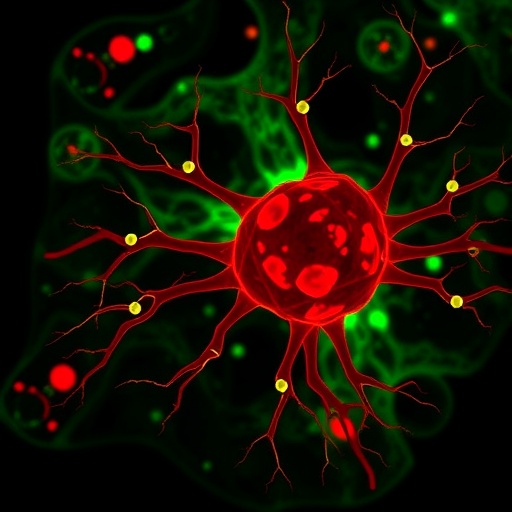In an illuminating new study poised to reshape our understanding of cancer progression, researchers have uncovered a critical role for neutrophils and their extracellular traps (NETs) in driving the vascular occlusion, tumor necrosis, and metastasis in solid tumors. The investigation reveals that the formation of NETs within the vasculature of tumors is not just a bystander effect but actively contributes to the blockade of blood flow, leading to the characteristic tissue damage and cancer dissemination. This paradigm-shifting discovery offers a fresh glimpse into the intricate cellular dynamics orchestrating tumor environments and opens promising avenues for therapeutic intervention.
For decades, tumor necrosis has been largely viewed as a passive consequence of unchecked tumor growth, associated with hypoxia and nutrient deprivation. However, the current findings challenge this dogma, demonstrating that pleomorphic necrosis within the primary tumor is an orchestrated event driven by immune cell-mediated vascular occlusion. Central to this process are low Ly6C-expressing neutrophils, which reside predominantly within the blood vessels and possess a greater propensity to form NETs. These NETs — networks of decondensed chromatin studded with antimicrobial proteins — physically obstruct the microvasculature, precipitating ischemic damage and subsequent necrosis.
To decode this mechanism, the researchers employed an elegant genetic model by generating mice deficient in protein-arginine deiminase 4 (PAD4) specifically in neutrophils. PAD4 is an essential enzyme for NET formation, catalyzing citrullination of histones that unfurls chromatin into extracellular webs. Mice lacking PAD4 in their neutrophils (referred to as PAD4^ΔN) provide a clean canvas to dissect the contribution of NETs within tumorigenesis. Upon transplantation of Lewis lung carcinoma (LLC) cells into these mice, a striking contrast emerged: while tumors formed in both PAD4^ΔN and wild-type (PAD4^WT) mice, those in PAD4^ΔN mice exhibited markedly diminished vascular damage, near-complete absence of citrullinated NETs, and significantly reduced necrotic regions.
.adsslot_Ll7Okb9QZj{ width:728px !important; height:90px !important; }
@media (max-width:1199px) { .adsslot_Ll7Okb9QZj{ width:468px !important; height:60px !important; } }
@media (max-width:767px) { .adsslot_Ll7Okb9QZj{ width:320px !important; height:50px !important; } }
ADVERTISEMENT
The implication is profound — NET formation is a driving force behind the necrotic architecture of tumors, refuting the notion that necrosis arises solely from hypoxia or tumor overgrowth. Detailed imaging revealed that in wild-type mice, neutrophil-rich areas within tumors coincided with substantial microvascular loss, evidenced by decreased CD31 staining of endothelial cells, whereas PAD4^ΔN mice retained intact vasculature in these regions. This finding firmly links NET-mediated vascular occlusion to ensuing tissue destruction.
Crucially, the biological ramifications of NET blockade extended beyond local tumor pathology to impact metastatic dissemination. The primary tumors formed in PAD4^ΔN mice gave rise to significantly fewer lung metastases both in terms of total metastatic burden and the number of metastatic foci. Intriguingly, the size of individual metastatic lesions remained comparable between genotypes, indicating that the defect lay not in the growth capacity of seeded cancer cells but in the capacity of tumor cells to exit the primary site. This was further corroborated with intravenous injection models where cancer cells already present in the bloodstream generated similar metastatic loads regardless of PAD4 status, highlighting the crucial role of NETs in tumor cell egress.
Pushing the translational envelope, the researchers explored the effects of disulfiram — an FDA-approved drug historically used for alcohol aversion therapy — recently recognized for its capacity to inhibit NET formation in lung injury models. Disulfiram treatment in a 4T1 breast cancer model resulted in diminished NET presence within tumors, reduced necrosis, and a striking reversal of pro-metastatic molecular signatures typically observed in necrotic tumors. Notably, this intervention curtailed lung metastases without affecting primary tumor growth, suggesting that targeting NETs disarms dissemination rather than tumor proliferation.
At the molecular dimension, RNA sequencing of cancer cells isolated from necrotic versus non-necrotic tumors unveiled that the presence of necrosis imparts a profound transcriptomic reprogramming. Tumor cells exposed to necrotic environments upregulated gene pathways related to hematopoiesis, epithelial-to-mesenchymal transition (EMT), enhanced migratory capacity, metabolic adaptation, and programmed cell death. EMT markers such as increased vimentin and decreased E-cadherin were markedly elevated in cancer cells in necrotic regions of PAD4^WT tumors but absent in PAD4^ΔN counterparts, underscoring the influence of the pro-necrotic milieu in fostering metastatic attributes.
These insights collectively paint a picture of neutrophils as double-edged swords within the tumor microenvironment. While conventionally appreciated for their antimicrobial roles, neutrophils — through NET release — contribute to a pathological cascade culminating in vascular occlusion, tumor tissue breakdown, and enhanced metastatic propensity. The identification of PAD4-mediated NET formation as a critical node in this process offers a precise molecular target for drug development.
Future work will need to validate these mechanisms across diverse tumor types and clinical settings. Additionally, deciphering the interplay between various neutrophil subsets, the vascular endothelium, and cancer cells may uncover further layers of regulation. Understanding how NETs influence immune evasion, angiogenesis, and the pre-metastatic niche will be pivotal in harnessing their pathological roles for therapeutic gain.
This study redefines tumor necrosis not as a passive hallmark but as an active, immune-driven process with tangible implications for metastasis. It highlights the complexity of tumor-immune cross-talk and propels NETs from a relatively obscure feature to a central axis of cancer biology. As research expands on these revelations, the prospect of NET-targeted therapies offers hope for reducing metastatic disease and improving patient outcomes.
The cell biology community and oncologists alike should take heed: neutrophils, far from mere first responders to infection, wield a potent influence on tumor fate. Unraveling the mechanistic underpinnings of NET-mediated vascular occlusion charts a promising roadmap for innovative cancer treatments, turning our immune cells’ weapons against cancer’s devastating progression.
Subject of Research: The role of neutrophil extracellular traps (NETs) in vascular occlusion, tumor necrosis, and metastasis in cancer.
Article Title: Neutrophils drive vascular occlusion, tumour necrosis and metastasis.
Article References: Adrover, J.M., Han, X., Sun, L. et al. Neutrophils drive vascular occlusion, tumour necrosis and metastasis. Nature (2025). https://doi.org/10.1038/s41586-025-09278-3
Image Credits: AI Generated
Tags: cellular dynamics in tumor environmentschromatin networks in tumor microenvironmentextracellular traps in tumor vasculatureimmune cells in solid tumorsischemic damage from neutrophilslow Ly6C neutrophils and cancerNETs and blood flow blockageneutrophils role in cancer progressionpleomorphic necrosis in cancertherapeutic interventions for metastasistumor necrosis mechanismsvascular occlusion and metastasis





